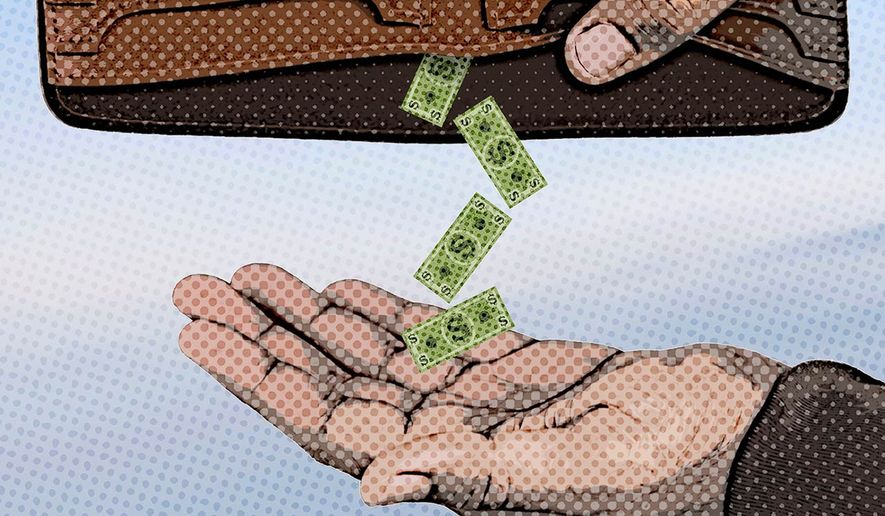OPINION:
Wages aren’t keeping up with inflation, and that will be a headache for President Biden in 2024.
Until COVID-19, real wages jumped 12.6% during the Trump expansion, as tax cuts and deregulation boosted economic growth well above what President Barack Obama accomplished.
Gross domestic product now exceeds pre-COVID levels, but since the pandemic recession, real wages are down 7.4%
In Europe, falling real incomes are a problem too, but how the pandemic was managed affected timing.
In America, greater emphasis was placed on direct aid to households, while in Europe, governments supported businesses more to keep workers on payrolls. During the pandemic, Europe managed to maintain real wages, but as economies reopened in 2022, inflation took off, and real wages dropped dramatically.
The convergence of the United States with European wage stagnation cannot be blamed on big businesses grabbing a bigger share of the economic pie. Rather, the problem lies in America becoming more like Europe.
Mr. Biden is spending more on health care subsidies, rebuilding infrastructure, publicly funded-R&D and industrial policies aimed at promoting the semiconductor, EV, battery and other green energy industries — without raising taxes much. Consequently, federal spending has increased to $6.2 trillion from $4.4 trillion in 2019, and the federal deficit has risen to $1.41 trillion from $984 billion.
The federal budget gap is now 5.4% of GDP. According to the Congressional Budget Office, it will hit 7.4% by 2033. The national debt will jump $21 trillion more, and that’s likely a conservative estimate.
In the next decade, interest payments could exceed nominal growth in GDP. Each year, borrowing enough just to pay interest would add to the national debt more than the economy expands.
Interest rates would increase dramatically. Massive cuts in Social Security, Medicare and the rest of the social safety net would be needed, or defense spending and other basic functions of government would have to be dramatically curtailed.
The administration apparently believes more spending can be financed by printing money with few consequences.
When the federal government issues new Treasury securities, either the Federal Reserve buys those and monetarizes the debt. Or those bonds become a good substitute for money because the average maturity of the federal debt is less than 7 years.
On corporate balance sheets, when bond holdings are properly date-of-maturity structured and hedged, Treasuries become interest-bearing liquidity.
Either way, ordinary households become poorer.
At full employment, more liquidity creates more inflation. Wages can’t keep up because the real economy can’t get any bigger. If businesses relent to worker demands for wages that meet or exceed recent price increases, inflation just accelerates — that happened in the 1970s, when more expensive imported oil juiced inflation.
The federal government can spend more by taxing to divert more of workers’ pay into health care, new roads and green energy, or it can create additional liquidity and inflation. At full employment, it can’t create a bigger economic pie, and inflation becomes an alternative to higher taxes.
Importantly during the recent inflation, corporate greed generally has not been the culprit.
Food companies have exploited shortages to seize unconscionable profit margins — Nestle at 17.1%, Kraft-Heinz and P&G 22.4% each, and Coca-Cola a whopping 27.4%.
Consumers have a right to be angry when they go to Safeway or Trader Joe’s, but more broadly, the average profit margin of the S&P 500 has been declining each quarter after inflation stoked up in early 2021.
If you want to know why your IRA or other pension accounts took a 20% hit last year, look to the West Wing, where deficit spending has become a religion. Anti-business policies like a higher minimum corporate tax and the 1% stock buyback tax make it worse.
The president’s foreign trade and investment policies have a decidedly protectionist bent. With globalization peaking and perhaps in retreat, foreign investors — new chips factories notwithstanding — are shunning the United States, and U.S. investment abroad is slowing too.
That is bad news for American workers because the U.S. affiliates of foreign companies pay wages above the average for the overall U.S. economy, and the affiliates of U.S. companies abroad pay less.
In layman’s terms, foreign investment creates high-wage jobs in America and exports low-wage jobs. Mr. Biden’s anti-free trade policies discourage that beneficial swap.
Other federal policies hurt too. Curtailing domestic oil production is contributing to record trade deficits and federal policies to push the adoption of EVs and green energy faster than the market would encourage instigates the inefficient use of capital.
Those reduce the size of the economic pie, as do social justice set-asides and union preferences in Mr. Biden’s infrastructure and industrial policies by reducing competition and price discipline.
Overall, it’s not the war in Ukraine or monopolies that are making Americans poorer, it’s too much government spending and meddling in the marketplace.
• Peter Morici is an economist and emeritus business professor at the University of Maryland, and a national columnist.




Please read our comment policy before commenting.